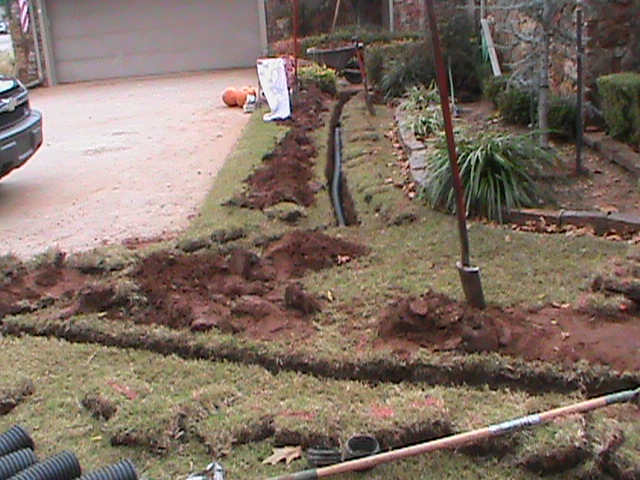
- Drainage System Installation
Angie's List has awarded CMG Sprinklers and Drains their top rating for customer service and lists CMG with an "A" rating. CMG Installs Drainage Systems, Lawn Sprinkler Systems and provides Expert Sprinkler System Repair. Our Drainage Systems utilize French Drains, Surface Drains, Channel Drains, and Sump Pumps. Sprinkler Systems installed by CMG use Rain Bird or Hunter Sprinkler Parts. With over 20 years of experience we provide top quality Sprinkler Systems, French Drains, Drainage Systems, and Sprinkler Repair.
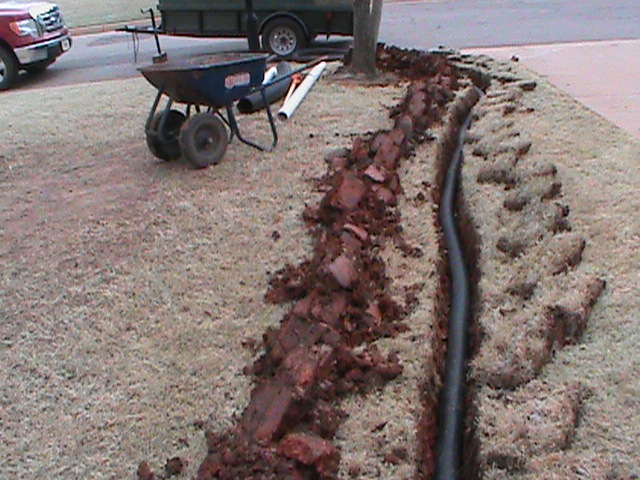
- French Drain Pipe running to curb outlet in Oklahoma City.
CMG Services all of Central Oklahoma including: Norman, Moore, Edmond, Yukon, Mustang, Oklahoma City, Midwest City, Del City, Blanchard, Newcastle, Purcell and Chickasha. 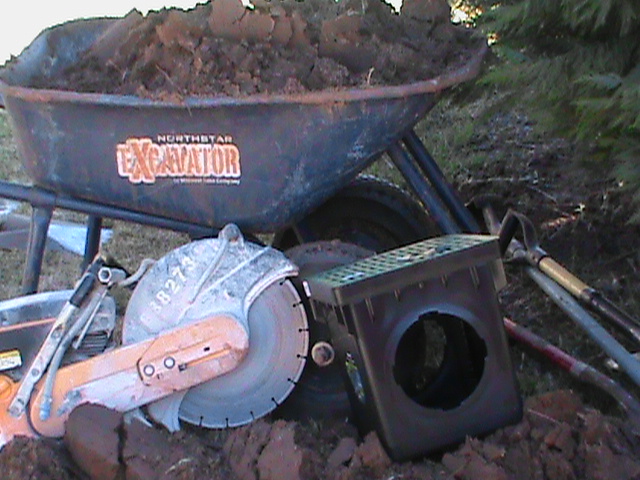
- Drainage System Installation in Norman
An example of a complex drainage system would be: A French Drain in the back yard connected to a Surface Drain near a flower bed connected to several gutter downspouts, which are connected to a Channel Drain going across a driveway, which is connected to additional Surface Drain in the front yard, which runs to a Curb Fitting that lets all the water drain out on to the street. A simple Drainage System might consist of a Surface Drain that is connected to a second Surface Drain which runs to a Pop-up Emitter which lets water drain over the curb and into the street. An "Exit Point" is the term used for where all the water leaves the Drainage System. Determining the Exit Point is very critical. It is one of the first things we do when diagnosing a Drainage Problem. Drainage Systems can: 1. Keep water away from foundations -- A French Drain is best because it can move Surface Water and Sub-Surface Water (water moving under ground) away from the foundation. Many times less experienced companies install Surface Drains to keep water away from foundations. This can be a big mistake. A Surface Drain can't move or drain Sub-Surface Water. Also A Surface Drain often can't move enough water fast enough and easily becomes overwhelmed during a heavy rain. A Surface Drain also can't cover or protect a broad enough area. Surface Drains should be designed in a Drainage System to be located in smaller Drainage Areas moving moderate amounts of water. Surface Drains look better than French Drains. If ,"appearance" is more important than Drainage Capacity, Go with the Surface Drain. Just know what you are getting into and what your expectations should be. One side of a foundation alone, can be over 100 feet. A 4 inch or 6 inch French Drain is best when protecting a large area such as a foundation. 2. Keep water away from small or inclosed areas. This might be a low area just through a gate on the side of a house, or the low area between a flowerbed and the wall of a house, or standing water on or near a sidewalk or driveway. These types of Drainage Problems are best served with Surface Drains. A Surface Drain can move water away from a low area that is relatively small. This can occur in yards, flowerbeds, sidewalks and driveways. A surface Drain is designed to move Surface Water away from a problem area to a predetermined exit point. Surface Drains are available in many sizes. How quickly they remove standing water is usually determined by the size of the pipe that is connected to the drain. Simply put, a Drainage System is one or a group of underground Drain Pipes that take water away from a place that has water standing on it or flowing across it. The water that is in the problem area, can be causing damage or may be inconvenient or both. (Usually Both) A simple Drainage System is a Drain for the water to enter, a Drain Pipe to move the water away from the Drain, and an Exit Point for the water to be released out of the Drain Pipe. Drainage Systems quickly can become more complicated. Considerations must include: How does the water get to the problem area? There may be one or many sources. Water Sources: 1. It falls from the sky directly 2. It flows down hill over the surface (surface water) 3. It flows underground under the surface (sub-surface water) 4. It flows from the edge of a roof ( There may be many roofs near the problem area, neighbors etc.) 5. It flows from a gutter downspout 6. It flows over the edge of a gutter because the gutter is too small is is clogged 7. It flows up from the ground (seeps and springs are common in Oklahoma) 8. It flows from a sprinkler system use ( yours or your neighbors) 9. It flows from a leaking pipe ( water mains, water meters, water lines, sprinkler pipes, sprinkler valves) There are other reasons for Drainage Problems, the above reasons are just the most common. Once the number of water sources is determined, a rough estimate of the amount of water that needs to be drained away on average must be estimated. This can be simplified down to "SMALL, MEDIUM, OR LARGE AMOUNTS OF WATER TO BE DRAINED AWAY. You don't have to be an engineer trying to calculate fluid dynamics. Experience at diagnosing drainage problems helps however. How much water needs to be moved will help determine the type and size of the Surface Drain or French Drain that needs to be installed. It also helps to determine the size of Drain Pipe required for the Drainage System. A good rule to follow is, "If in doubt, install a larger Drain and Drain Pipe." Unused Drainage Capacity is better than property damage caused by a Drain that is overwhelmed by too much water. For home and small business use typical materials used are: 6 inch, 9 inch, and 12 inch Surface Drains - 3 inch, 4 inch, and 6 inch Drain Pipes -- 3 inch, 4 inch, and 6 inch French Drains -- French Drains move more water than Surface Drains -- French Drains move Surface Water and Sub-Surface Water Surface Drains move Surface Water only Surface Drains look nicer than French Drains in most cases Once the type and number of drains is determined and what size Drain Pipe will connect them, an exit point must be selected. (Where is the Drainage System going to take the water to and release it?) The Drainage Curb Fitting is installed when the desired exit point for the French Drain will release the Drainage Water into the Street. The Drainage Curb Fitting is rectangular in shape and made to be installed through the curb. A small section of Curb is cut out with a concrete saw. The Section is a few inches wider than the Drainage Curb Fitting. We then install new concrete around the curb fitting. Once the concrete has dried, the Drain Pipe coming from a French Drain or Surface Drain is connected to the Drainage Curb fitting and then covered with dirt.
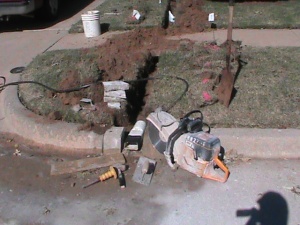
The Drainage Pop-Up Emitter is connected to the end of a Drain Pipe. It is downhill from a French Drain or a Surface Drain. It is a small release basin with a green pop-up lid. When releasing water, it pops up about an inch to release the water from the French Drain or Surface Drain. When the Storm Water has moved through the Drainage System and out of the Pop-Up Emitter, the green lid closes back to its original closed position. The emitter is designed to release water out into a yard or down a hill or other desirable Drainage Exit Point where there is no curb.
Drainage System installation and design is a big part of our business. Does your sidewalk turn into a moat after a hard rain? Does part of your yard look like a pond after a thunderstorm? Worst of all, are you experiencing concrete deterioration to your foundation, sidewalk, or driveway. CMG can design a Drainage System to solve your Drainage Problems. Our Drainage Systems can be simple or complex. We utilize, French Drains, Surface Drains, Channel Drains, Basin Drains, Basement Drains, Trench Drains, and Sump Pumps. Estimates are free!
Just what is a "French Drain?" Many times people incorrectly use the phrase, "French Drain," to apply to many different types of Drains that could be used in a Drainage System. The term is widely used and many times incorrectly connected to "Surface Drains," or "Channel Drains." A Surface Drain has a grate that sits on top of a basin. The basin is underground. A Drain Pipe is connected underground to an outlet on the Drain Basin. Storm-Water Drains through the grate into the Drain Basin. Once in the Drain Basin, water travels out of the basin through a Drain Pipe. The Storm-Water continues downhill in an underground Drain Pipe to an exit point.
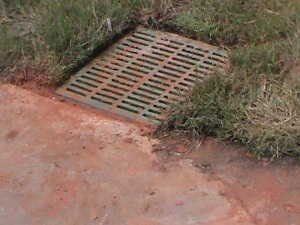
- Surface Drain Installed next to sidewalk in Oklahoma City.
A trench is dug that is slightly wider than the French Drain Pipe that is being used. There are several sizes. Three Inch, Four Inch, and Six Inch are the most common sizes of French drain Pipe. The dirt that is taken out to make the trench is hauled away. It is replaced by some type of small stone or gravel depending on what is desired or available. I prefer crushed 1 inch lime stone. It is the most economical option in my area. Pea Gravel or some other type of small stone can work just as well. The lime-stone or gravel is placed in the trench on top of the perforated Drain Pipe and filled all the way to the surface (ground level). In some cases where the French Drain needs to be deep or is being placed in sandy soil, a special trench liner must be placed in the trench before the perforated Drain Pipe or the Gravel are installed. This helps maintain the integrity of the trench over time. It also increases the cost of the French Drain and the amount of time to install it. I install a trench liner in a French Drain about 20% of the time. Most of the time a liner in not needed.
A French Drain is designed to handle a large volume of water and cover a large area. The Drain
is anyplace the trench goes. It has many applications and can be used
in many situations. It can be installed by itself or incorporated into a Drainage System with Surface Drains or Gutter Down-Spouts connected to it.
The main downfall of a French Drain is that they, for the most part aren't very pretty. They don't look very nice in a yard once they are completed.
Depending on the area the French Drain is installed and the type of grass around the French Drain, will dictate whether grass grows over the lime stone. Grass can grow up and through the gravel in the French Drain over time eventually covering the gravel. This is OK. It won't have a measurable effect on the performance of the drain.
DONT COVER THE GRAVEL IN THE FRENCH DRAIN WITH DIRT. THE FRENCH DRAIN WON'T WORK IF THE TRENCH IS CLOGGED WITH DIRT. DON'T EVEN INSTALL IT IF YOU ARE GOING TO COVER IT UP WITH DIRT.
DECORATIVE STONE CAN BE USED TO COVER A FRENCH DRAIN AND THEY LOOK GREAT AND LAST A LIFETIME.

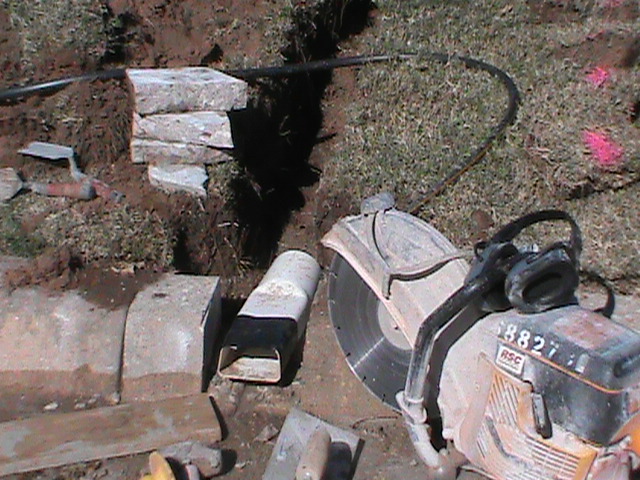
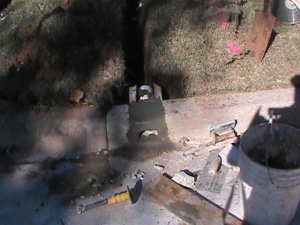
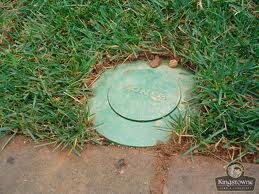
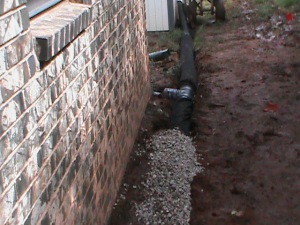
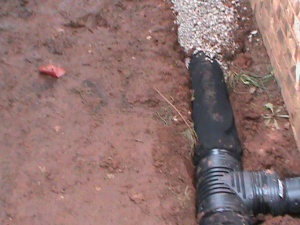
No comments:
Post a Comment